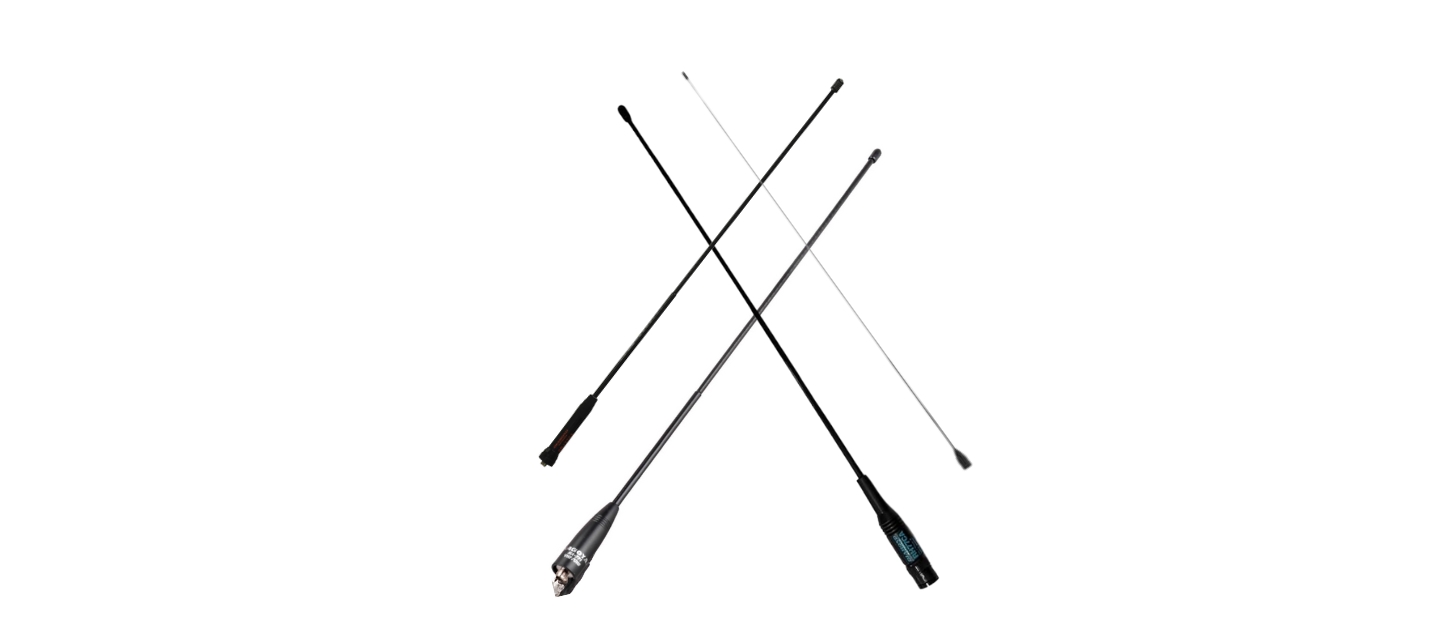VHF/UHF handheld antennas play a critical role in the performance of VHF and UHF radios. These compact antennas must efficiently radiate and receive RF energy while operating without a traditional ground plane.
Although limited by size and the portable nature of the radio, well-designed antennas can still offer solid performance when paired with smart operating practices. Upgrading from stock antennas often results in noticeable improvements in range, clarity, and signal strength.
How VHF/UHF Handheld Antennas Work
A typical handheld transceiver antenna is a quarter-wave or loaded quarter-wave radiator. Because a handheld radio lacks a dedicated ground plane, the user’s body and the radio chassis act as a counterpoise.
When you hold the radio upright, you complete part of the ground return path, enabling the antenna to function properly. However, this design limits efficiency, especially when compared to mobile or base station antennas.
The radiating element is often coiled or shortened for convenience. This compact design trades bandwidth and gain for portability. Still, manufacturers optimize these antennas using matching networks or inductive loading to compensate for the reduced length.
Creating a Ground Plane on a Handheld
Handheld antennas don’t have a ground plane in the traditional sense. Instead, the radio and the user’s hand simulate part of the needed counterpoise. For better results, especially during testing, some operators use a counterpoise wire. This simple wire, cut to a quarter-wavelength, dramatically improves SWR and radiation efficiency.
Because the body contributes to grounding, antenna performance varies with position, orientation, and how you hold the radio. Holding it upright, away from metal surfaces or your face, can often yield stronger signals.
Getting More Performance from Aftermarket Antennas
Swapping the stock antenna with a quality aftermarket model almost always improves performance. Manufacturers ship handhelds with short “rubber duck” antennas that prioritize convenience over gain. Aftermarket antennas, however, often offer greater length, optimized loading coils, or gain-oriented designs.
For even better performance, choose an antenna matched to the bands you use most. A longer whip usually performs better than a short stubby antenna, though it sacrifices portability. In many cases, adding a tiger tail can boost the effectiveness of both stock and aftermarket whips.
Although base-loaded and center-loaded designs differ slightly, each style can enhance range depending on the application. For urban use, compact antennas may be best, but in open terrain, longer whips often pull in more distant signals.
Is Single or Dual-Band Better?
Single-band antennas are usually more efficient than dual-band designs for a given size. They focus all tuning and physical structure around one frequency range, such as 2 meters or 70 centimeters. This allows better gain and lower loss for that specific band. However, dual-band antennas offer more flexibility.
For users who regularly switch between 2m and 70cm, dual-band antennas are more practical. Although they may lose a bit of performance compared to optimized single-band models, the convenience often outweighs the tradeoff. In some cases, multi-band antennas attempt to cover three or more bands, but this usually results in greater compromises.
Top 5 VHF/UHF Handheld Antennas (Ranked by Performance)
Diamond SRH77CA
This long dual-band whip antenna provides excellent gain on both 2 meters and 70 centimeters. Its length allows for better radiation efficiency, especially when combined with a counterpoise.
Although longer than most, it significantly improves both transmit and receive. Many operators report up to double the range compared to the stock rubber duck.
Nagoya NA-771
A widely-used, high-performance dual-band antenna, the NA-771 balances size and gain well. It performs admirably on both bands, and while slightly more flexible than the SRH77CA, it delivers similar performance at a lower cost. Because of its popularity, it’s essential to buy from trusted sellers to avoid counterfeits.
Comet SMA-24
Designed for dual-band use, this antenna offers great flexibility and moderate gain. Its flexible whip resists damage while providing clear improvement over stock antennas. Though slightly shorter than the SRH77CA, it still outperforms many bundled models and works well in both handheld and mobile environments.
RH-770 (Telescopic)
This telescopic antenna extends to a full quarter-wave on 2m and 5/8 wave on 70cm. Because of its efficient design and adjustable length, it outperforms most fixed whips. However, it’s not ideal for rugged field use and requires careful handling. Despite this, it shines in portable field operations or testing setups.
Signal Stick Antenna
Made from flexible memory wire, this lightweight antenna delivers solid dual-band performance while remaining nearly indestructible. Although not the highest-gain option, its durability and reasonable efficiency make it a favorite among emergency communicators and field operators.
Additionally, it bends rather than breaks, which makes it safe for backpacking and mobile use.

Additional Notes on VHF/UHF Handheld Antennas Use
VHF/UHF handheld antennas performance isn’t just about the hardware. Your surroundings, body position, and environment play major roles. For best results, hold the radio upright, away from buildings or metal surfaces. Raising the radio just a few feet above head level can often improve reception significantly.
Also, always check your radio’s connector type before purchasing a new antenna. Most handhelds use SMA connectors, either SMA-Female or SMA-Male.
Finally, understand that handheld antennas are a compromise. While you can’t replicate base station performance with a whip on a walkie-talkie, careful selection and smart use can greatly extend your range, increase your clarity, and improve your operating experience.
When you’re chasing repeaters in the city or working simplex on a hike, your choice of antenna makes a big difference. Investing in a quality aftermarket antenna and optimizing your technique gives your handheld radio the voice it deserves.
